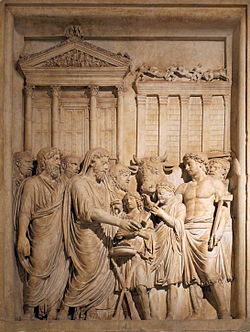| Religion in ancient Rome |
|---|
 Marcus Aurelius (head covered) sacrificing at the Temple of Jupiter |
| Practices and beliefs |
| Priesthoods |
| Deities |
|
| Related topics |
|
The bacchanalia were Roman mystery cults to the wine-god and seer Bacchus. Introduced from the Greek colonies of southern Italy around 200 BC, they were based around various ecstatic elements of the Greek Dionysian mysteries, with ancient but obscure connections to Rome's existing native cult to Liber. According to Roman sources, the Bacchanalia were originally restricted to adult women, but were subsequently corrupted by a priestess who introduced violent, sexually motivated initiations of men and youths of both sexes, and all classes. An official investigation of 186 BC determined the Bacchanalia rites as irreligious, subversive, even murderous; a threat to public safety, morality and the state itself. In the same year, the Senate published legislation to purge the Bacchanalia of undesirable elements, govern its priesthoods, restrict its numbers and participants, and punish offenders. Six thousand are said to have been executed. Thereafter, the reformed Bacchanalia rites may have been merged with the Liberalia festival.
History
The bacchanalia were based on the Greek Dionysian mysteries, which had been transplanted at some unknown time to the Greek colonies in Southern Italy. Very little is known of its rites, as ; like all mystery cults it was celebrated in strict privacy, and its initiates were bound to secrecy. It probably reached Rome around 200 BC. Livy, the principal literary source on the Bacchanalia, tells that the cult arrived in Rome from two sources, both of them Roman neighbours with long-term Greek influences and contacts - Etruria, where a Greek "of humble origin, versed in sacrifices and soothsaying" established a nocturnal version of the rites and a substantial following of women and men by adding wine and feasting to the rites;[1] - and Campania, where a Bacchic priestess named Paculla Annia seems to have propagated a women-only version of the cult, a daylight ritual held on three days of the year.
From around 188, Paculla Annia is said to have presided over the corruption of Bacchus's rites and holy orgia, making them nocturnal, increasing their frequency to five a month, and opening them to all social classes and both sexes - starting with her own sons. In Livy's account, wine-fueled violence and sexual promiscuity became essential features of the cult's celebrations and initiations, less a cult of catharsis than liberation taken to dangerous extremes. Under legitimate cover of religious secrecy, the cult officials, priests and acolytes were free to break any civil, moral and religious laws with impunity. Men and women of all ages and classes mixed promiscuously, without restraint: young initiates of both sexes were sought, found and if they resisted, forcibly initiated. The cult's opponents, resisters and apostates were threatened with ritual murder, "hurried off to hidden caves, and they were said to have been taken away by the gods." The cult seemed to function independently of the state, its hierarchy and its morality; or even against them. It had particular appeal to the uneducated and fickle minds (leuitas animi) - the young, the lower classes, plebeians, women, the young, morally weak, and "men most like women" - but even Rome's highest class was not immune. Hispala Faecenia, an ex-initiate and prostitute, fearing the cult's vengeance but more fearful for her young, upper class protege-lover, revealed all this to the consul Postumius, who presented it to a shocked Roman senate. Once investigations were complete, the senate suppressed the cult - or rather, forced its reformation through the Senatus consultum de Bacchanalibus - and had 6,000 offenders put to death. [2] Livy's broad account of the Bacchanalia may be considered broadly correct, though some of its tropes and the implausibly circumstantial speeches given by his dramatis personae probably draw more on Roman satyr plays than on the Bacchanalia themselves.[3]
The Senatus consultum de Bacchanalibus brought the Bacchanalia under the control of the senate, and thus of the Roman pontifices. Congregations of mixed gender were permitted, but were limited to no more than two men, and three women. All Bacchic rites required the prior permission from the senate. The consultum of 186 has been interpreted as an assertion of Rome's civil and religious authority, either throughout the Italian peninsula or within Roman territories, following the recent Punic War and subsequent social and political instability, represented by such cults as the Bacchanalia.[4] Even after their official suppression, Illicit Bacchanals persisted covertly for many years, particularly in Southern Italy, their likely place of origin.[5][6][7]
In Livy's opinion, the Bacchanalia cult's deepest offence was the indiscriminate mixing of freeborn Romans of both sexes and all ages at night, when passions of any kind are easily aroused; wine and opportunity only abetted such behaviours, be they "natural" or "unnatural". Women at these gatherings, he says, outnumbered men; and in Livy's text, the consul Postumius stresses the overwhelmingly female nature of the cult and its organisation. Against this, the Senatus consultum allows women to outnumber men, by three to two, at any permitted gathering. Gender does not seem to have motivated the Senate's response more than any other cause.[8] Gruen notes that almost all cult leaders named by Livy are male, which seems to eliminate even a perceived conspiracy of women. Rather, the Senatus consultum may have intended to display the Senate's collective power to Rome's Italian allies, and to remind its own aspiring politicians, populists and generalissimos that the Senate's collective authority trumped all personal ambition.[9]
Modern usage
In modern usage, bacchanalia can mean any ecstatic or drunken revelry.
- Tableau 4 of Alexander Glazunov's ballet The Seasons is entitled "Bacchanale".
- In John Steinbeck's novel East of Eden, the atmosphere of Jenny's whorehouse is described as "tavern bacchanalianism".
- In Philip Roth's novella "Goodbye Columbus", Roth uses "bacchanalian paraphernalia" to describe Mr. Patimkin's stocked bar.
- In Donna Tartt's novel The Secret History, four of the central characters hold a bacchanal, which leads to two murders.
- In 1938, John Cage invented the prepared piano for a Syvilla Fort dance work titled Bacchanale.
- In the classic 1983 comedy movie “A Christmas Story”, co-writer and film narrator Jean Shepherd described the hectic holiday season as a “. . . yearly bacchanalia of peace on earth and goodwill to men. “
See also
- Anthesteria
- Dionysian Mysteries
- Ganachakra
- Maenads, female worshippers of Dionysus
- Saturnalia, a Roman festivity
- Thriambus, a hymn sung in processions in honour of Dionysus
References
- ^ Sarolta A. Takács, Politics and Religion in the Bacchanalian Affair of 186 B.C.E., Harvard Studies in Classical Philology, Vol. 100, (2000), p.305.
- ^ Erich S. Gruen, "The Bacchanalia affair", in Studies in Greek Culture and Roman Policy, University of California Press, 1996, p. 34 ff.[1]
- ^ The plots of Greek-based Satyr plays would have been familiar to Roman audiences from around the 3rd century BC on. See Robert Rouselle, Liber-Dionysus in Early Roman Drama, The Classical Journal, 82, 3 (1987), p. 191.[2]; Paculla Annia is unlikely to have introduced all the changes attributed to her by Livy: see Erich S. Gruen, Studies in Greek Culture and Roman Policy, University of California Press, 1996, pp 48 - 54: Hispala Faecina embodies the dramatic trope of "golden-hearted prostitute", whose courage and loyalty outweigh her low origin and profession, and her fear of reprisal: see Victoria Emma Pagán, Conspiracy Narratives in Roman History, University of Texas Press, 2004, pp. 61 - 65.
- ^ During the Punic crisis, some foreign cults and oracles had been repressed by Rome, but on much smaller scale and not outside Rome itself. See Erich S. Gruen, Studies in Greek culture and Roman policy, BRILL, 1990, pp.34-78: on precedents see p.41 ff.[3]
- ^ See Sarolta A. Takács, Politics and Religion in the Bacchanalian Affair of 186 B.C.E., Harvard Studies in Classical Philology, Vol. 100, (2000), p.301. [4]
- ^ Beard, M., Price, S., North, J., Religions of Rome: Volume 1, a History, illustrated, Cambridge University Press, 1998, pp. 93 - 96.
- ^ For Livy's account, see Livy, The History of Rome, Vol 5, Book 39
- ^ Schultz, C., Women's religious activity in the Roman Republic, UNC Press Books, 2006, p. 93.
- ^ Gruen, E. Studies in Greek culture and Roman policy, University of California Press, 1996, Ch. 2.
 Chisholm, Hugh, ed. (1911). "Bacchanalia". Encyclopædia Britannica (11th ed.). Cambridge University Press.
Chisholm, Hugh, ed. (1911). "Bacchanalia". Encyclopædia Britannica (11th ed.). Cambridge University Press.- Euripides, Bacchae, a Greek tragedy, gives some insight as to what was involved in a Bacchanalian rite.
- Bacchanales. Actes des colloques Dionysos de Montpellier (1996–1998). Textes réunis par Pierre Sauzeau. Montpellier: Publications de l'Université Paul Valéry, 2000, 300 pp. (ISBN 2-84269-382-5); Cahiers du GITA nº 13 (ISSN 0295-9900).
- Livy's History of Rome
External links
- Senatus consultum de Bacchanalibus in Latin at The Latin Library
- Senatus Consultum de Bacchaniabus in English and Latin at forumromanum.org
- Description of the Bacchanalia and the Senate's ruling from Fordham
- Matthias Riedl, "The Containment of Dionysos: Religion and Politics in the Bacchanalia Affair of 186 BCE," International Political Anthropology 5 (2012) No. 2, pp. 113-133.